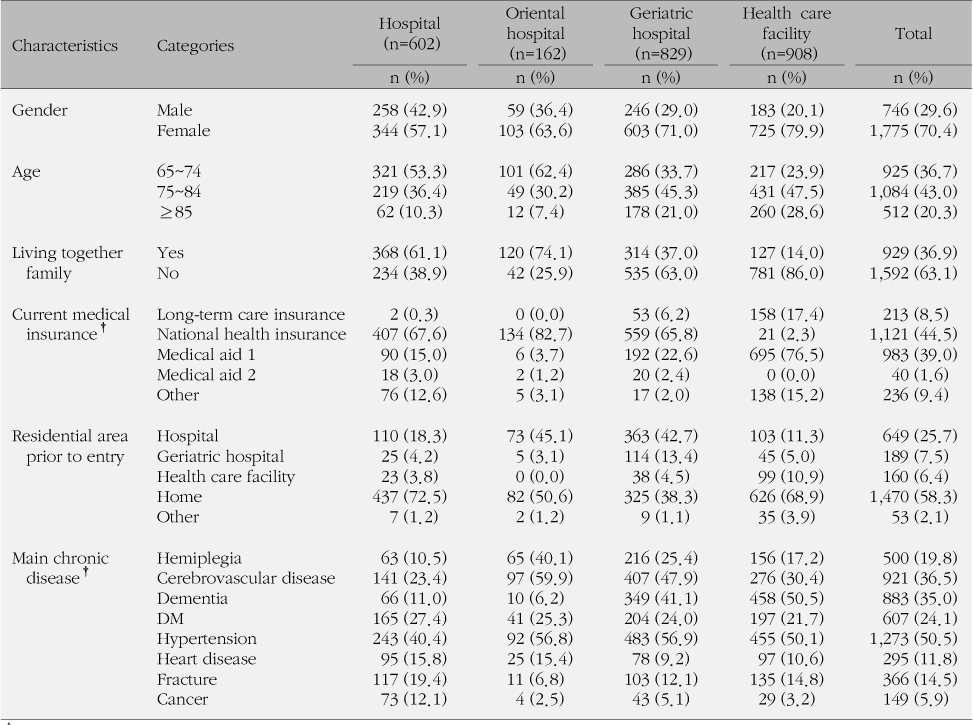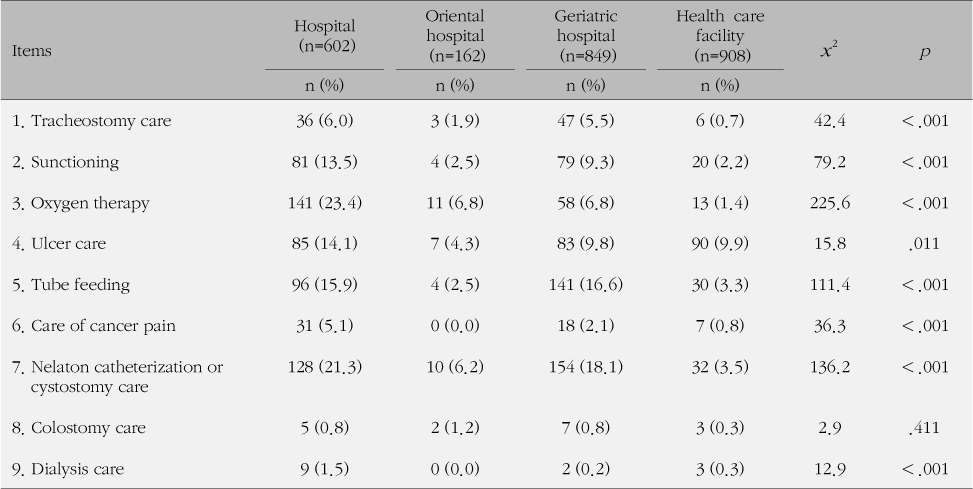Articles
- Page Path
- HOME > J Korean Acad Community Health Nurs > Volume 21(4); 2010 > Article
-
Original Article
- The Comparison of Functional Status and the Level of Health Care Needs in Elderly Koreans in Health Care Institutions
- Hyun-Sil Kim, Young-Mi Jung, Hung-Sa Lee, Yoo-Hyang Cho, In-Young Yoo
-
Journal of Korean Academy of Community Health Nursing 2014;21(4):386-397.
DOI: https://doi.org/10.12799/jkachn.2010.21.4.386
Published online: April 4, 2014
1Professor, Department of Nursing, Daegu Haany University, Korea.
2Assistant Professor, Department of Nursing, Daegu Haany University, Korea.
3Associate Professor, Department of Nursing, Chodang University, Korea.
4Assistant Professor, Department of Nursing, Jeonju University, Korea.
• Received: August 25, 2010 • Revised: November 16, 2010 • Accepted: November 23, 2010
© 2010 Korean Academy of Community Health Nursing
This is an Open Access article distributed under the terms of the Creative Commons Attribution Non-Commercial License (http://creativecommons.org/licenses/by-nc/3.0/) which permits unrestricted non-commercial use, distribution, and reproduction in any medium, provided the original work is properly cited.
- 684 Views
- 1 Download
- 2 Crossref
Abstract
-
Purpose
- The purpose of this study was to compare functional status and the level of health care needs in elderly Koreans in health care institutions.
-
Methods
- Data were collected from 2,521 elderly patients admitted in 50 health care institutions (hospitals, oriental hospitals, geriatric hospitals, and health care facilities) selected through proportional stratified sampling in 2008. We used a long-term care (LTC) assessment tool developed by the government, which consists of 52 items with 5 subscales.
-
Results
- Statistically significant differences were detected in functional status and the level of health care needs among the subjects in different health care institutions. Of the sample population in geriatric hospitals, 48.9% were eligible for LTC Category 1, 20.9% for Category 2, and 17.2% for Category 3, and 13.1% of the subjects were not eligible for any of the categories. Of the sample population in health care facilities, 29.9% were eligible for LTC Category 1, 20.5% for Category 2, and 21.8% for Category 3, and 27.0% of the subjects were not eligible for any of the categories.
-
Conclusion
- The findings of this study indicate the necessity of the development of an evaluation system that helps determine whether a subject is eligible for LTC.
- 1. Bliesmer MM, Smayling M, Kane RL, Shannon I. The relationship between nursing staffing levels and nursing home outcomes. J Aging Health. 1998;10:351–371. ArticlePubMedPDF
- 2. Carpenter I, Perry M, Challis D, Hope K. Identification of registered nursing care of residents in English nursing homes using the Minimum Data Set Resident Assessment Instrument(MDS/RAI) and Resource Utilization Groups version III (RUG-III). Age Ageing. 2003;32:279–285. PubMed
- 3. Goold SD. Trust and the ethics of health care institutions. Hastings Cent Rep. 2001;31(6):26–33. ArticlePubMed
- 4. Hambleton RK, Robin F, Xing D. Item response models for the analysis of educational and psychological test data. In: Tinsley H, Brown S, editors. Handbook of Applied Multi-variate Statistics and Mathematic Modeling. San Diego, CA: Academic Press; 2000. p. 553–585.
- 5. Health Insurance Review & Assessment Service. Health insurance reimbursement fee. Seoul: Aramedit; 2008.
- 6. Health Insurance Review & Assessment Service. Geriatric hospital evaluation data 2009;07 30 Retrieved August 5, 2009. from http://www.hira.or.kr/rec_diag_serch.do?pgmid=HIRAA030102000000#1
- 7. June KJ, Lee JY, Yoon JL. Effects of case management using resident assessment instrument-home care(RAI-HC) in home health services for older people. J Korean Acad Nurs. 2009;39(3):366–375. ArticlePubMed
- 8. Jung KH, Oh YH, Suk JE, Do SR, Kim CW, Lee YK, et al. The 2004 survey on the living profile and welfare service needs of older persons. Seoul: Korea Institute for Health and Social Affairs; 2005.
- 9. Kim B, Hong S. A psychometric revision of the Asian values scale using the Rasch model. Meas Eval Couns Dev. 2004;37:15–27. Article
- 10. Kim EK. Care time of elderly in long-term care facilities. J Korean Acad Nurs Adm. 2003;9(3):353–366.
- 11. Kim SR. A study on the comparison of inpatients healthcare utilization between the Medicaid recipients and the insured. Seoul: Yonsei University; 2000. Unpublished doctoral dissertation.
- 12. Korea Health Industry Development Institute. A study on the optimal supply of acute care beds and long-term care beds. Seoul: Korea Health Industry Development Institute; 2008.
- 13. Korea National Statistical Office. Census of elderly population in Korea on 2008 year. Seoul: Korea National Statistical Office; 2008.
- 14. Lee H, Lee HY, Lee J. Predictors of facility adaptation nursing home residents. J Korean Acad Nurs. 2009;39(2):177–185. Article
- 15. Lee JY, Jang SM, Kim JH, Song SH, Yoon JY, Ju JS. A study on revision of health insurance payment system in geriatric hospital. Seoul: Health Insurance Review & Assessment Service; 2007.
- 16. Lee SH. Multi-level analysis of factors related to quality of services in long-term care hospitals. J Korean Acad Nurs. 2009;39(3):409–421. ArticlePubMed
- 17. Lee SH, Kim ER, Kim SM, Kim EK, Park SK, Oh JH. A study on the optimal supply of long-term care beds and specialized hospital beds. Seoul: Korea Health Industry Development Institute; 2001.
- 18. Lee TW, Cho SY, Jang YK. Predictors of nursing service need for nursing homes residents. J Korean Acad Nurs. 2009;39(1):95–106. ArticlePubMed
- 19. Miller EA, Weissert WG. Predicting elderly people's risk for nursing home placement, hospitalization, functional impairment and mortality: A comparative review and analysis. Med Care Res Rev. 2000;57(3):259–297. ArticlePubMedPDF
- 20. Ministry of Health and Welfare. 2006 Elderly welfare facility data 2006;11 15 Retrieved January 15, 2008. from http://www.mw.go.kr/front/jb/sjb0602vw.jsp?PAR_MENU_ID=03&MENU_ID=030602&page=1&BOARD_ID=900&BOARD_FLAG=02&CONT_SEQ=39574&SEARCHKEY=TITLE&SEARCHVALUE=노인복지시설&SCH_SILKUK_ID=&SCH_DEPT_ID=&CREATE_DATE1=&CREATE_DATE2=
- 21. National Long-Term Care Planning Committee. A study on development of public long-term care system. Seoul: Ministry of Health and Welfare; 2004.
- 22. Park JY, Kang IO, Kwon JH, Lee JS, Han EL. The 3rd pilot project evaluation of long-term care insurance. Seoul: National Health Insurance Corporation; 2008.
- 23. Park JY, Kim KH, Ku MK, Han MH, Kim JY, Park JY, et al. A study on operation management in long-term care insurance system. Seoul: National Health Insurance Corporation; 2004.
- 24. Phillips CD, Hawes C. Care provision in housing with supportive services: The importance of care type, individual characteristics, and care site. J Appl Gerontol. 2005;24(1):55–67. ArticlePDF
- 25. Roh YK, Sunwoo D, Yoon JR, Won JW, Lee DW, Lee DH, et al. A study on the role of long-term care facility and geriatric hospital. Seoul: Ministry of Health and Welfare; 2010.
- 26. Sugai Y. Problems of integration of medical care and welfare service: Medical treatment under long-term insurance system. Psychogeriatrics. 2006;6:139–144. Article
- 27. Sunwoo D. A study on health system construction of the elderly in aging society. Seoul: Korea Institute for Health and Social Affairs; 2005.
- 28. van Campen C, van Gameren E. Eligibility for long-term care in the Netherlands: Development of a decision support system. Health Soc Care Community. 2005;13(4):287–296. ArticlePubMed
- 29. Walker LO, Avant KC. Strategies for theory construction in nursing. 3rd ed. Norwalk, CT: Appleton & Lange; 1994.
- 30. Yi JJ. Application of RUG-III for long-term care elderly patients. Seoul: Yonsei University; 2000. Unpublished doctoral dissertation.
Figure & Data
References
Citations
Citations to this article as recorded by 

- Comparison of Perceived Health Status, Social Support and Residential Satisfaction in Long-term Care Hospital and Nursing Homes
Dongwon Yun
Journal of East-West Nursing Research.2016; 22(1): 24. CrossRef - Predictive Factors associated with Death of Elderly in Nursing Homes
Kiwol Sung
Asian Nursing Research.2014; 8(2): 143. CrossRef

 KACHN
KACHN





 PubReader
PubReader Cite
Cite

